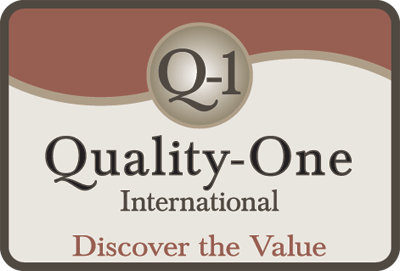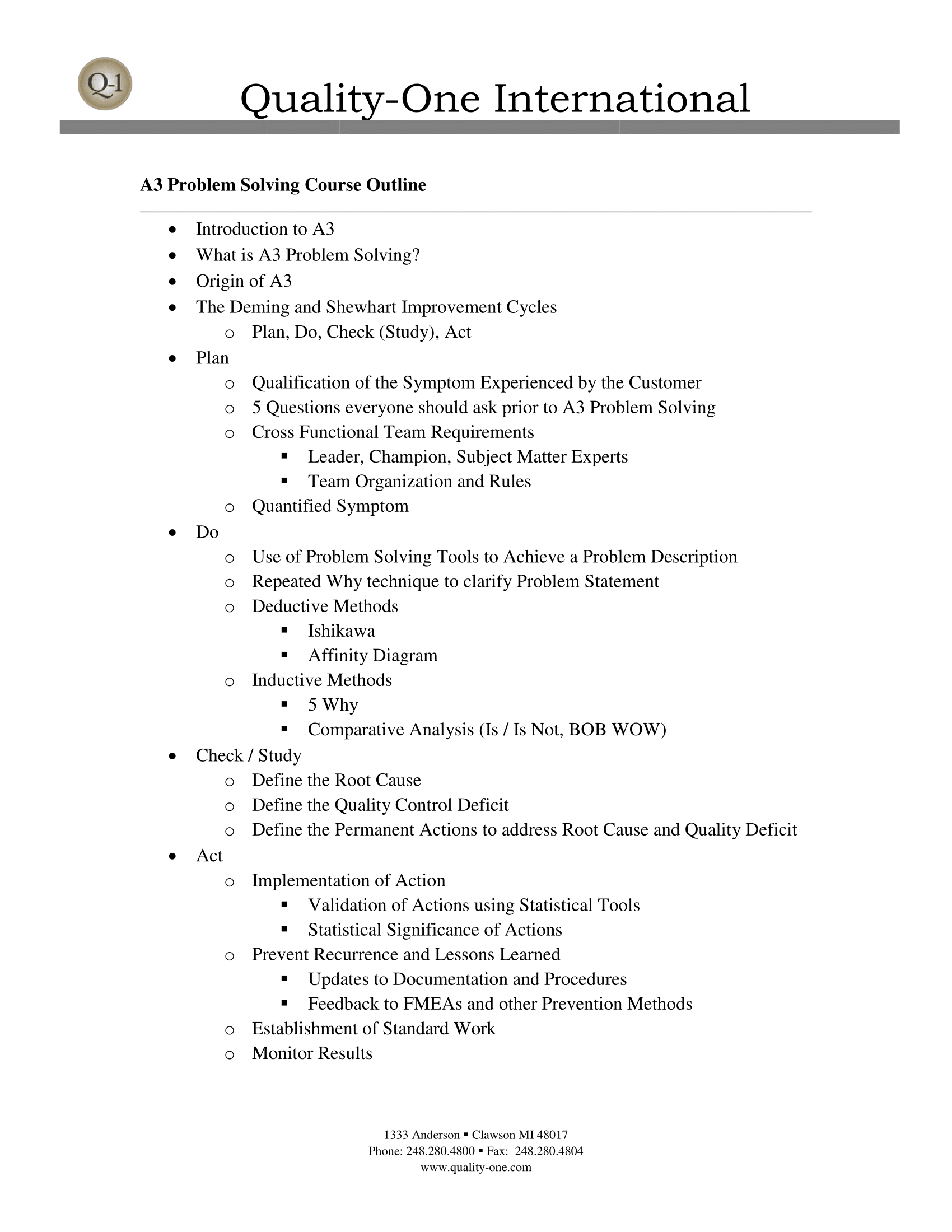A3 Problem Solving
– The A3 Report –

Introduction to A3 Problem Solving
In order for any business to be successful, they must strive to improve quality and efficiency as well as build a problem solving continuous improvement culture. The A3 Report is a very useful problem solving and continuous improvement tool. It was first used by Toyota and is quickly gaining popularity in industry today. Companies must start to view problems as opportunities for improvement. The A3 Report format allows the entire problem identification, clarification, analysis and resolution steps to be documented on one single sheet of paper.
What is A3 Problem Solving
The name “A3” is actually derived from a standard European paper size similar to 11” by 17”. The A3 Report is based upon the Plan, Do, Check, Act (PDCA) Method. The PDCA process is sometimes referred to as the Deming Wheel or Deming Circle. The A3 Report incorporates this basic premise to problem solving and continuous improvement.
Why Implement A3 Problem Solving
Some problem solving tools involve numerous pages of information, multiple charts and graphs and lengthy reports. The A3 Report format can be used to more effectively communicate all of the pertinent information with greater visual impact. While the A3 Report is an effective communication tool, it is actually much more valuable as a problem solving and critical thinking tool that can be used to drive continuous improvement. The A3 Report fosters a problem solving / continuous improvement mindset within the participating team members. It is an excellent tool for managers and supervisors to share problem solving techniques with their teams. With resources being limited, completion of a formal A3 Report may not be applicable to every problem. Its use should be determined based upon the size of the problem and its impact on the business or organization. The A3 Report and the A3 way of thinking are valuable tools for Lean initiatives and for integrating a problem solving culture throughout the organization.
How to Implement A3 Problem Solving
The A3 Report usually consists of multiple steps following a PDCA structure of Plan, Do, Check, Act. The number of steps can vary due to the different formats being used for the A3 Report. The exact number of steps used is not as important as the end result. The A3 Report can utilize various forms depending upon the organizations needs and preferences. The following paragraphs provide information regarding the basic steps and some tools used to complete the A3. One thing that all of the forms seem to have in common is that they follow the PDCA problem solving process. The basic steps and where they fall into the PDCA structure are listed below:
Plan
- Define the Problem:
The first step is to define the problem or identify the need for improvement:
- Define the ideal state, the operational standard or the desired condition
- Describe the current situation or status
- Identify the Gap or problem
- How is the current status different from the desired state or operational standard?
- State your goals and explain how performing the A3 and closing the gap would benefit the organization
- What value will be realized by completion of the A3 exercise?
- Containment:
In some A3 formats, a section is included for immediate countermeasures or containment actions. The purpose of containment is to prevent further problems from occurring or prevent the current problem from causing negative effects to other processes, products or departments.
- Breakdown the Problem:
Next, the team should breakdown or further define the problem. Ask any relevant 5W (What, When, Where, Who, Why) and 2H (How, How many / How often) questions. There also may be more than one issue contributing to the problem or more detail required to properly address the problem. Prioritize the issues and identify the point of occurrence or escape point.
- Define goals:
The A3 team should set goals regarding the improvement desired as a result of the exercise. This could include a percentage of improvement in process throughput, reduction in number of defects per unit or processing time. The goals should be specific, measureable, realistic, achievable and timely. Many companies are adopting the SMART goal approach.
- Root Cause Analysis:
The team should perform a Root Cause Analysis (RCA) of the problem by using various quality tools. The tools could include, but are not limited to data analysis or completing a Cause and Effect or Ishikawa diagram followed by a 5 Why exercise. Whatever method selected, it is important to get past the symptoms of the problem and down to the root cause.
- Countermeasures:
Permanent countermeasures or corrective actions must then be determined to address the root cause. The countermeasures must be clearly defined, achievable by the person responsible and have a due date. Corrective actions that do not have an owner or due date are seldom achieved.
Do
- Implementation:
A plan for implementation of the corrective actions should be developed. The plan should include the team members, resources and time required to complete each task. In some cases, support from outside resources or test facilities are required. Some countermeasures may require repair or replacement of tooling or other capital expenditures. Therefore, proper levels of management should be kept informed throughout the process to assure adequate resources are available for implementing any corrective actions.
Check
- Monitoring and Validation:
The A3 team should next confirm the effectiveness of the countermeasures. This can be accomplished in many ways, including but not limited to additional quality checks, Statistical Process Control (SPC) data, process or product audits and customer feedback.
Act
- Standardize and Improve:
During this phase of the A3, the team should take action to standardize the process changes or improvements. The team must update all standard work, work instructions and process control plans, etc. In addition, it is a good practice to perform a short Things Gone Right / Things Gone Wrong (TGR/TGW) exercise and document in the A3 report what went well during the process and what could use improvement. The management team should also promote continuous improvement of the A3 tool within the organization.
Common problems to avoid with the A3 Report:
- The background is not well developed
- The problem statement is not well defined or unclear
- The ideal state or target condition is actually an action item, not the desired result
- Analysis does not drill down to the root cause(s)
- Ineffective countermeasures that will not prevent the problem from re-occurring
- Validation and monitoring methods are not well documented or there is a lack of evidence of improvement
Always remember that the A3 process and report are about fostering critical thinking. Encourage A3 thinking within your organization. The A3 process should be focused on improvement through developing the skills of the people. A3 thinking promotes problem solving, communication and mentoring of the teams.
The A3 Report is an effective visual tool for driving improvement and promoting a problem solving way of thinking. The format can and does vary depending upon the company or organization. The format you select is not as important as the results of the exercise. As long as the form contains the basic steps for problem identification, root cause analysis, corrective action and monitoring improvement or performance, it will be a very effective tool. The A3 Report has its roots in the automotive industry but is branching out into many different applications and industries from manufacturing to healthcare.
A3 Problem Solving Services
A3 Services from Quality-One include A3 Problem Solving Consulting, A3 Problem Solving Training and A3 Problem Solving Project Support, such as Facilitation and Auditing. Our experienced team of highly trained professionals will provide a customized approach for developing your people and processes based on your unique needs. Whether you need Consulting to assist in the design of your A3 process, Training to help understand and drive improvement through the A3 report, or hands-on Project Support for building and implementing your A3 process by utilizing our experienced Subject Matter Experts (SME) to work with your teams, Quality-One can help you promote A3 thinking in your organization.
Learn More About A3 Problem Solving
Quality-One offers Quality and Reliability Support for Product and Process Development through Consulting, Training and Project Support. Quality-One provides Knowledge, Guidance and Direction in Quality and Reliability activities, tailored to your unique wants, needs and desires. Let us help you Discover the Value of A3 Consulting, A3 Training or A3 Project Support.


